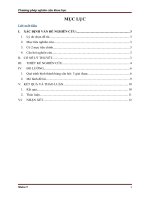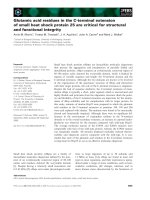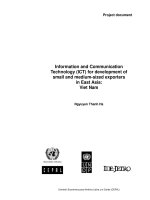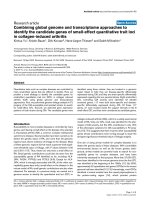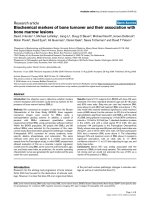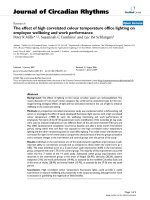employee turnover and retention strategies of small and midium enterprise service businesses in hanoi
Bạn đang xem bản rút gọn của tài liệu. Xem và tải ngay bản đầy đủ của tài liệu tại đây (1.26 MB, 94 trang )
i
Employee Turnover and Retention Strategies of Small and Medium Enterprise
Service Businesses in Hanoi
A RESEARCH PROPOSAL PRESENTED TO THE FACULTY OF
GRADUATE SCHOOL
SOUTHERN LUZON STATE UNIVERSITY LUCBAN, QUEZON,
PHILIPPINES
THAI NGUYEN UNIVERSITY S.R. VIETNAM
IN PARTIAL FULFILLMENT OF THE REQUIREMENTS FOR THE DEGREE
DOCTORS IN BUSINESS ADMINISTRATION
Advisor : Prof Conrado Abraham
Name: Ngo Thi Mai
ThAi nguyen University Southern luzon STATE University
Socialist Republic of Vietnam Republic of Philippines
Acknowledgments
I would like to express our most sincere thanks to the Management Board of
the Southern Luzon State University, Thai Nguyen University, the teacher, the teacher
of the school has helped me facilitate the learning process throughout.
I would like to express sincere gratitude and profound Professor Conrado L.
Abraham , enthusiastic teacher who have dedicated guidance, encouragement, spend
time and exchange orientation for me during this research.
I would like to express my sincere thanks to the Department of Employment -
Ministry of Labour - Invalids and Social Affairs, Department of Labour, War invalids
and Social Affairs Hanoi. the SMEs service business in Hanoi has helped me
research material, through a questionnaire survey.
I sincerely thank the Board of the University of Labor and Social affair
(ULSA), colleagues in ULSA, classmates DBA1 facilitated enthusiastic help and share
my experience to help complete the thesis.
Finally, I would like to send the gift to the heart of my family has passed
enthusiasm and encouragement to complete my thesis
iii
Table of contents
Page
Chapter I: Introduction
1.1.Background of the study 1
1.2.Statement of the problem 4
1.3. Significance of the study 6
1.4.Scope and limitation of the study 9
CHAPTER II: REVIEW OF RELATED LITERATUES AND
STUDIES
2.1 Literature Review
11
2.2 Theoretical and conceptual framework 31
2.3 Hypotheses 36
2.4 Definition of terms and Variable 39
CHAPTER III: RESEARCH METHODOLOGY
3.1 Research Design 51
3.2. Research Locals 52
3.3 Samples and Sampling 52
3.4 Instrumentation 53
3.5 Procedure
53
3.6 Statistical Analysis of the Data
54
CHAPTER IV: RESULTS AND DISCUSSION
4.1 Results 58
iv
4.2. Discussion 60
CHAPTER V: SUMMARY, CONCLUSIONS AND
RECOMMENDATIONS
5.1 Summary 69
5.2 Conclusions 74
5.3 Recommendations 75
List of tables and Exhibit :
Page
Figure 1.1 Employee Turnover 4
Figure 1.2 Voluntary Turnover Rate 5
Exhibit 1.1. Adam' Equity Theory 35
Table 1.2 Definition of SMEs in Vietnam 39
Chart No 4.1 : Applicability of Exclusive organizational structure
strategy
58
Chart No 4.2 : Applicability of Mobile benefit strategy
59
Table 4.3 Sex of employees of SMEs service businesses
Chart 4.3 Sex of employees of SMEs service businesses.
60
Table 4.4 Age of employees of SMEs service businesses
Chart 4.4 Age of employees of SMEs service businesses
61
Table 4.5 Qualification of employees of SMEs service
businesses
Chart 4.5 Qualification of employees of SMEs service
63
v
businesses
Table No 4.6 :Chi- square table for Exclusive organization
structure strategy
64
Table 4.7: Chi - square table for Mobile benefit strategy 66
Table 4.8 : Table for Inside communication strategy 68
Figure 5.1: Employee preference for staying the company 69
Figure 5.2: Reasons for attrition in SMEs service
businesses in HN
70
Figure 5.3: Percents of solvable attrition by Exclusive
organization structure in SMEs service businesses in HN
72
Figure 5.4: Figure 5.4: Attrition among employees who
value mobile benefit structure
73
Figure 5.5: : Percents of solvable attrition by Mobile
benefit structure in SMEs service businesses in HN
74
Table No 6.1: Questionnaire data
82
1
CHAPTER I: INTRODUCTION
1.1. Background of the study
A general idea of the sustained presence of service is very important to understand the research
environment. In addition to employee welfare such as pension fund, employees of SMEs are
entitled to many other benefits including:
+) Group Insurance: This plan is to provide coverage for employees in the event of
illness, injuries or pregnancy in case of female workers and spouse for male workers.Special,
personal accident insurance covers insury-related health care expenses. .
+) Personal Health Care (Regular medical check-ups): The SMEs service businesses
offer yearly health check-up for their employees. These medical checkups are normally carried out
once or even twice a year in some companies.
+) The lunch and Transportation subsidy: The lunch is providing by their organization
and it is also subsidized. Beside, some companies provide transportation facilities to all the
employees from home to the office at the lowest price.
+) Credit Card businesses: Credit card businesses allow prompt payment and cost
effectiveness that formal employee performance for purposes such as travel related expenses, hotel
bills, airfare, etc.
+) Recreation, Cafeteria, ATM and Concierge facilities: Recreational facilities include
billiard tables, chess tables and coffee bars. Esoecially, taffs in some hotels can enjoy equipped
gyms with private trainers.
2
+) Mobile Phone, Laptop: On the basis of business need, companies provide their staffs
with mobile phones and/or laptops. Staffs are responsible for the maintenance and protection of
this property.
+) Loans:
Many SMEs service businesses provide small loans for some different
cases. For example, employees could be provided with financial aid in emergency medical
situations or financial assistance at the time of their weddings. New members could be granted
loans to assist them in resolving their original work at the company.
+) Educational Benefits: Many SMEs service businesses develop policies to improve
personality and knowledge level of their employees., They reimburse tuition fees, and also fees for
exam and books.
+) Performance based incentives: Many SMEs business services have planned, and
implemented program-based support. The parameters for calculation are performance evaluation
criteria such as: speed, accuracy and productivity of each process. From there, they give to some
different bonus
+) Flexi-time: Some employees in the company but not all, may be able to choose the
flexi-time. The main target is to provide employees with flexible time schedule. The manager give
their staffs right to choose most effective working time for them instead of a fixed schedule.
Therefore the productivity will be enhanced.
+) The cultural exchange programs: Companies often hold staff parties, in which
they can join, share opinions and even display their talents. In addition, organizations also conduct
various sport competitions such as foot ball, volleyball for their employees.
+) Wedding Day Gift: Every employee in the company always receives a gift in his
wedding. The gift can be different based on their levels in the company. But it often fluctuates
between 20-50 USD for a member.
3
+) Employee Referral programs: There are companies which give good policy for
employees if they can recommend qualified people to work in the organization. The main target is
to attract the good employee for their company and create higher retention rate
+) Employee Stock Option Plan. To generate loyalty of employees, the company has
launched this policy; every staffs will be able to buy shares of company with discounted price.
This will enable them to fully enjoy benefits of the company.
So why is turnover rate still high? What retention strategies should be applied in the SMEs
service business in Hanoi?
1.2. Statement of the problem
An important issue facing by the SMEs service business is minimizing turnover rate. In the
context of globalization, Small and medium scale enterprises (SMEs) are losing a large number of
employees, especially excellent managers for large multinational companies. Particular data is as
follow:
Figure 1.1 Employee Turnover
4
0%
2%
4%
6%
8%
10%
12%
14%
16%
18%
E
xecutiv
e
M
a
nagem
e
nt
Pr
o
f
essi
onal
s
Busi
ness/
service
sup
por
t
P
ro
duct
i
on
S
uppor
t
A
ll
l
e
vels
Series1
EM PLOYEE TURNOVER
Figure 1.2 Voluntary Turnover Rate
Voluntary Turnover Rate
0%
2%
4%
6%
8%
10%
12%
14%
16%
18%
1
Years
Percents
Series1
Series2
Series3
Series4
Series5
Series6
Series7
2007 2008 2009 2010
2011
2012
5
2012 Towers watsson: Vietnam Labour Market Overview Trends
Employee turnover is permanent withdrawal from an organization whether voluntary or
involuntary. Straightforward ways to explain it are "how long employees tend to stay" or "the rate
of traffic through the revolving door". “Turnover is measured for individual companies and for
their service as a whole. If an employer is said to have a high turnover relative to its competitors, it
means that employees of that company have a shorter average tenure than those of other
companies in the same service”(
2012 Towers watsson.
High turnover can be harmful to the
company's productivity if skilled workers often leave the labor population and contains a high
percentage of new employees. Therefore, the company has a deep interest in the turnover rate of
their employees, because workers can replace a portion of the cost of business operations. When a
company to replace a worker, it incurs costs directly and indirectly. All the tasks that must be
performed during cost money, time or both. Additionally, there may be a loss of productivity
during the period after the employee leaves the former and new staff have been fully trained. For
some companies, employees can also replace it difficult to retain customers or clients that the
employee worked. . Often managers view the company as a success or just a stepping stone to
climb to the prestigious multinational companies. We are left as they are being raised in power.
How can design strategies to retain employees? Well as consideration to choose the best strategy
to be applied in employees retention. This is a difficult question that many Small and Midium
Enterprise Service Businesses in Hanoi are eager to find answers.
1.3. Significance of the study
Success in employee retention and attraction is very important for long term health and success
of any organization. The ability to retain and keep your best employees ensurescustomer
satisfaction, employees satisfied, retain institutional knowledge and learning and succession
planning effectively.
6
Do not retain a key employee is costly to any organization because in addition to the cost to recruit
and select a new employee other issues such as training time and investment; lost knowledge, and
possibly insecure co-workers will all have an impact on the company.
Attraction and retention of staffs in particular “key employees” is one of the largest challenges for
the company
The traditional approaches to attract and retention are not as effective due in part to generational
change and there is a need to take a more multi dimensional approach to the issue.
Retaining
qualified employees in a labor intensive, demanding, and fast-paced work environment is a major
struggle in the hospitality service. With the growth of tourism nationwide and the development of
hotels, resorts, restaurants, spas and casinos, there is a limited supply of staff that are well-trained
and experienced in the day-to-day operations, leaving a limited pool of qualified employees to
hire. So that,
Firstly, retaining qualified, high-performing employees is crucial to an organization.
Challenging hiring process: From a large pool of candidates, the HR professional screens
job applicants and carry out preliminary interviews. Shortlisted candidates are then forwarded to
managers who make further judgments to ensure that the most appropriate candidates are hired.
Hiring the right candidates normally requires lots of time.
Costly orientation and training: As an individual starts a new job, he is often given
orientation which informs him about organization goals, culture and background. Also, training is
provided to help new employee have necessary skills to perform his work. When an individual
suddenly leaves an organization, it would cause wastage of time and money. The HR department
would be required to start all over again the recruiting process for vacancies as well as conduct
other orientations and training. Searching for appropriate staff is a tedious task and it is a huge
waste of effort when an employee quits.
7
High possibility of resigned worker joining competitors: When this happen, employees may
bring strategies, policies from their current company to the new one. Many secrets of previous
organization may be revealed in case of leaking out essential data, document, and statistics.
Companies can limit such cases by requiring new joiners sign a document promising not to
divulge any information as they leave. Another effective way to retain employees is to implement
strict policies to prevent people from joining competitors.
Better performance of long-term employees: Compared to workers who change jobs often,
people who work for a long period have more experience in working for the company because
they understand its rules and policies as well as its culture. Therefore they can perform their duties
much better.
Time for individual adjustment with others : Normally time is required to let people know
and get on well with each other. An employee will understand his workmates better if they work
together for longer time therefore the productivity will be enhanced. Adjustment problems occur
as someone is replaced for an existing staff. Others tend to find it difficult to make a comfort level
with the new comer. Moreover, after establishing a certain relationship with the old staff, they face
a challenge in adjusting with the new one and especially trusting him. It is common that people
compare a new person with the previous employee and always discover his faults.
Loyalty from long-term individuals: As someone sticks to an organization for a long time, he
normally receives more benefits and incentives thereby forming a favor toward the management.
Necessity in retaining qualified and experienced employees: High-performing employees are
important to every company as they can bring their creativity, difference, boost the productivity
and help in achieving better outcome for the organization. Organizations will definitely struggle
without these top performers therefore it is essential to keep them staying happy and not looking
for changes. The management needs to value those who can bring real benefits to companies and
make special effort to retain as well as encourage them.
8
Secondly, Retention is a big challenge
Considerable changes are occurring in the labor market and offices which lead to altering the way
company link to its workers. Selecting, recruiting and retaining knowledgeable staffs have become
a serious concern to any organization and business. To become leading player in an industry, it is
essential for companies to meet their people’s needs by understanding them and applying
appropriate strategies.
Robust economic growth, changes in people mind about entering a profession, corporate retreats,
young workforce, and life balance have led to a fierce battle for skilled employees. At the same
time, people have different views about working. They tend to be more family oriented, pay more
attention to living standard and job status.
To retain people and attract new talents, it is important that managers learn the reasons for
fluctuations in labor market and be able to determine what their people want to fulfill their needs.
There are harsh competitions between companies for scare talented workers.
Inside communication is a tool to make employees understand about their own working place, feel
good about it and perceive equity.
1.4.Scope and limitation of the study
1.4.1 Scope of the study
This study aims to determine the applicability of three new employee retention plans in the SMEs
service businesses in Hanoi. This will help the SMEs service businesses to retain valuable
employees.
1.4.2 Limitation of the study
1. The study only concentrates on urban service area in Hanoi. Workers in other areas
might have dissimilar job preferences. Therefore, the applications of these studies are limited in
Hanoi city only.
9
2. The study’s findings and conclusions demonstrate current trends in the organizations.
10
CHAPTER II: REVIEW OF RELATED LITERATURE AND STUDIES
2.1 Literature Review
2.1.1 Employee turnover
“Since the employee turnover has been discussed, its nature, reasons, advantages and drawbacks
were the major issues to be considered” (Morrell, Loan-Clarke and Wilkinson, 2004; Hong, Wei
and Chen, 2007; Massingham, 2008). Bowden (1952) implied that “in some situations personnel
turnover can be a positive change within an organisation”. He said “the employee turnover is
needed due to reasons such as a company growth or a market demand, which requires an internal
organisational change”. Nonetheless, “personnel changes are more often seen to have negative
impacts on a company rather than positive effects” (Parker and Skitmore, 2005; Massingham,
2008). Those changes are unavoidable so learning the employee turnover reasons would be
necessary to minimize its negative consequences.
2.1.1.1 Types of staff turnover
2.1.1.1 Types of staff turnover
Turnover has been described as employee's “movements across organizational boundaries” (Hong,
Wei and Chen, 2007, p.808). However, the word could also be used to imply within organizational
movements. This section will consider both external and internal turnover, accordingly.
“Employee turnover is frequently considered to be involuntary, or anticipated, and voluntary, or
unanticipated, in its nature” (Morrell, Loan-Clarke and Wilkinson, 2004;
Hong, Wei and Chen, 2007). Involuntary staff rotation is the case where decision is made by the
organization and employees themselves cannot make much influence about their movements. On
the other hand, voluntary turnover happens when an employee makes decision to move to another
department or company. “External involuntary employee turnover can take place because of a
company's strategy or policy, or a need to downsize its personnel” (Hong, Wei and Chen, 2007). It
11
was said “to be of a lesser interest for organization as it is known in advance and its extent and
consequences are easily defined” (Hong, Wei and Chen, 2007).
2.1.1.2 Reasons for employee turnover
Many researches have been carried out to find out the reasons for turnover. Generally, “the causes
can be divided into two categories – inevitable and avoidable reasons” (Bowden, 1952; Hong, Wei
and Chen, 2007).
Company shrinkage, retirement, parental leave, permanent illness or death result in unavoidable
external involuntary staff turnover. “Inevitable reasons are perceived as an element of
organization’s normal life” (Bowden, 1952), and therefore their existence emphasize that it is
impractical to consider organization’s personnel as an unchangeable environment while planning
resource allocation and managing the company in general.
Dissatisfaction might not be an original reason for staff rotation but it is the middle phase of the
process. This is caused by various factors making employees dissatisfied with his job. Laser
(1980) argues: “The most widely spread misconception about an employee's motive to leave is
salary discontent. This opinion is widespread due to employees' stating salary dissatisfaction as a
reason to leave a company. This reason is often used because of its neutrality, comparing to other
causes such as conflicts with management or colleagues” (Laser, 1980).
Furthermore, an improper employment procedure, “improper employee expectations set during the
employment, lack of formal training, and tensions between the employee and his direct
management”(Laser, 1980).
It is essential for an organization to "find the right men for the right jobs" (Bowden, 1952, p.73). .
These will cause voluntary or involuntary, external or internal turnover. However it could be
avoided, “an organization should appreciate their selection process more and invest sufficient time
and resources in investigating who is a suitable person to be employed” (Laser, 1980).
12
Other cause for employee dissatisfaction was referred by Laser (1980) is “setting inappropriate
expectations upon the job”. Management often makes mistakes in employment process by
emphasizing only benefits of someone’s future job, making him over fancy and get uninspired
when taking over his new responsibilities. It is said that: “Causes job dissatisfaction is providing
insufficient training for a new employee” (Laser, 1980). Training gives employees knowledge
about organization operation, its culture and also provide him necessary skills to fit better in the
company. Training failure can make new employee struggle with new challenges therefore lead to
job dissatisfaction.
Lastly, “tensions between employees and management as a reason for staff turnover “Laser (1980)
. It can be: “Especially crucial to manage employees accurately during an organizational change”
(Morrell, Loan-Clarke and Wilkinson, 2004). Employees may choose to exit the organization if
they are not clearly explained the reasons for changes or received sufficient help from employer
when changes taking place.
The previous reasons of “Turnover and other causes identified by diverse researchers” (see
Morrell, Loan-Clarke and Wilkinson, 2004, for a summary) can be a ground for both kinds of
voluntary staff turnover: “internal voluntary staff rotation” (willing for changes inside an
organization) and “external voluntary turnover” (cross-organisation movement). “Voluntary staff
turnover can also be caused by an employees' eagerness to self-develop and have career growth
opportunities” (Bowden, 1952; Morrell, Loan-Clarke and Wilkinson, 2004). Employees have a
tendency to be more ambitious and more motivation for achieving further development and
promotion. In case: “The current position does not encourage career growth, an employee's job
satisfaction can deteriorate, which can prompt the intention to search for new work or affect
performance at the present one” (Hong, Wei and Chen, 2007).
However, “There is no general agreement upon the relationship between an employee's
performance and staff turnover” (Hong, Wei and Chen, 2007). There are four general opinions
13
regarding the issue. The opinions claim that the staff's performance and employee turnover are
found in (Hong, Wei and Chen, 2007): “A positive relationship, a negative relationship; no
relationship, and a non-linear relationship”
In the summary, “high performers tend to leave an organisation more often than others”.(Hong,
Wei and Chen (2007)). Other studies indicate that poor performing employees tend to change job
more often. However, Birnbaum and Somers (1993, cited in Hong, Wei and Chen, 2007) asserted
that: “ there is no relationship between an employee's performance and his or her intention to leave
a company or change a position” . Lastly, some research have shown that both excellent and poor
performing workers are in risk of switching jobs often, yet employees with medium level are more
willing to stay within an organization.
According to Hong, Wei and Chen (2007), “the negative correlation was proved to be accurate in
more studies than others, meaning that employees with poor performance are more probable to
leave organization”. This raised “the discussion on whether companies should strive to reduce
turnover of such employees” (Bowden, 1952). Decreasing avoidable employee rotation is not
always recommended as keeping non-performers is harmful to an organization.
2.1.1.3 Consequences of employee turnover
. “Staff rotation is widely seen as a harmful phenomenon and thus its disadvantages are usually
considered” (Laser, 1980; Morrell, Loan-Clarke and Wilkinson, 2004; O’Connell and Kung, 2007;
Massingham, 2008). Furthemore “employee turnover incurs financial expenses to an organisation
and therefore the disadvantages are often presented as direct and indirect costs” (Morrell, Loan-
Clarke and Wilkinson, 2004).
“Each employee who leaves his position in particular or organisation in general causes the
organisation inevitable additional expenses” (Laser, 1980). “Those are costs of recruiting a new
14
employee” (O’Connell and Kung, 2007), “higher unemployment taxes” (Laser, 1980), “temporary
replacement staff” (Morrell, Loan-Clarke and Wilkinson, 2004), “which all result in decreased
company profitability” (Schmitt, Borzillo and Probst, 2011).
However, many researchers agree that “indirect costs associated with staff turnover are much
higher and thus more problematic for organisation” (Laser, 1980; Morrell, Loan-Clarke and
Wilkinson, 2004).
Indirect costs of staff turnover proved to be “less tangible and therefore difficult to quantify”
(O’Connell and Kung, 2007). These indirect expenses are associated with:
1) “costs of training of new staff “(Laser, 1980; Morrell, Loan-Clarke and Wilkinson, 2004);
2) “decreased morale within organisation” (Bowden, 1952; Laser, 1980; Morrell, Loan-Clarke and
Wilkinson, 2004; O’Connell and Kung, 2007);
3) “emotional pressure on remaining staff “(Morrell, Loan-Clarke and Wilkinson, 2004);
4) “additional workload for remaining staff during employment and training of new personnel”
(O’Connell and Kung, 2007; Massingham, 2008);
5) “decreased productivity during a new employee adaptation period” (O’Connell and Kung,
2007; Massingham, 2008);
6) “deteriorated product or service quality” (Laser, 1980; Morrell, Loan-Clarke and Wilkinson,
2004; O’Connell and Kung, 2007; Massingham, 2008; Schmitt, Borzillo and Probst, 2011);
7) “lost social capital” (Morrell, Loan-Clarke and Wilkinson, 2004; Massingham, 2008);
8) “lost human capital “(Massingham, 2008);
9) “lost structural capital” (Morrell, Loan-Clarke and Wilkinson, 2004; Massingham, 2008).
Although they are considered to be complicated to calculate, indirect costs are seen to be of high
significance to companies. As can be seen from the listing above, employee turnover affects many
15
stakeholders – remaining staff, employees involved in recruitment process, people who
temporarily occupy vacant position and newcomers employed for holding it permanently.
When staff turnover occurs, be it voluntary or involuntary, colleagues of a person leaving are
affected. “Losing a team member is seen to have a negative impact on the team spirit and its
development” (Tuckman and Jensen, 1977). Because, “the workload of other team members may
increase in short term, which causes more emotional tensions and decreased quality of work done”
(O’Connell and Kung, 2007) as well as “increasing job dissatisfaction of the remaining staff” .
Massingham (2008) asserts that: “another essential outcome of employee turnover is loss of a
company's social and structural capital, or loss of organisational memory and deteriorated learning
ability, accordingly” . When an employee leaves company, he or she takes organisational
knowledge with him or her. Nowadays, as it has been discussed earlier, “organisational knowledge
is seen as crucial success factor for businesses” (Massingham, 2008). Therefore, they strive to
prevent knowledge loss by making it less dependent on people who carry it and by striving to keep
key knowledge holders within the company.
Bowden (1952, p.73) claims that “in case external involuntary staff turnover is caused by
downsizing, it negatively affects remaining employees” as they "contemplate what is happening to
their fellow workers". Schmitt, Borzillo and Probst (2011) support this opinion stating that
“downsizing reduces staff productivity”. However, it can be suggested that remaining employees
can be observed to work harder in case they perceive good performance as the only way not to
become a downsizing statistics as well.
The real question: there exists no research that research considers employee turnover as a positive
phenomenon?. Schmitt, Borzillo and Probst (2011, p.56) mention that “downsizing is sometimes
perceived to provide” "sustainable performance improvement". Bowden (1952) states, that “a
degree of employee turnover is needed for the healthy being of organisations”. Therefore, it can be
claimed that unavoidable staff rotation is better for a company than endeavours to keep personnel
16
static and thus fail to meet new market requirements and adapt to dynamic contexts in which a
company operates.
Similar conclusions were drawn by Arvidsson (2009) who said it was noteworthy that there is not
much research on positive outcomes of tensions within matrix organisations. He thus suggested
further research to concentrate on possibilities provided by tensions, which were identified during
his study.
Unlike academic publications, industry-focused business publications include some endeavours to
perceive employee turnover from its positive side. Lau and Albright (2011) propose that
“companies should analyse whether each case of staff rotation affects them in an advantageous or
disadvantageous manner”. They also claim that “occasionally employee turnover can serve an
organisation in a positive way granting growth opportunities for current talented staff, allowing a
company to employ new people with greater potential, and diversifying abilities and background
of staff” (Lau and Albright, 2011). “Employee rotation can encourage a company to improve their
staff development program and other undertakings that motivate remaining employees to develop
themselves and their working capabilities” (Lau and Albright, 2011).
It could be suggested that employee turnover can increase a company's productivity and morale in
case a poor performer is being replaced by a more efficient person. However, it is definite that
firing every employee who underperforms cannot be seen as a fruitful solution. In such a case it
could be useful to identify the employees with
poor performance with a view to improve their work results given that some training and coaching
is provided by employer.
Lau and Albright (2011) agree that “turnover of employees with high performance and important
knowledge is more harmful to a company than helpful”. However, they claim, “possibilities
provided by staff turnover should not be neglected”.
2.1.2 Employee retention strategies
17
Retention is a complex concept and there is no single recipe for keeping employees with a
company. In literature, retention has been viewed as “an obligation to continue to do business or
exchange with a particular company on an ongoing basis” (Zineldin, 2000). A more detailed and
recent definition for the concept of retention is “customer liking, identification, commitment, trust,
readiness to recommend, and repurchase intentions, with the first four being emotional-cognitive
retention constructs, and the last two being behavioral intentions” (Stauss et al., 2001). Studies
have also indicated that “retention is driven by several key factors, which ought to be managed
congruently: organizational culture, communication, strategy, pay and benefits, flexible work
schedule and career development systems” (Logan, 2000). Increasing numbers of organization
mergers and acquisitions have left employees feeling displeased from the companies that they
work and haunted by concerns of overall job security. As a result, employees are now making
strategic career moves to guarantee employment that satisfy their need for security. On the other
hand, employers have a need to keep their stuff from leaving or going to work for other
companies. In fact, “companies that offer employee development programs are finding success
with retaining workers” (Logan, 2000). This is true because of the great expenses associated with
hiring and retraining new employees. The adage, “good help is hard to find, is even truer these
days than ever before” because “the job market is becoming increasingly tight” (Eskildesen &
Nussler, 2000). In fact, literature on employee retention shows that “wooing
existing employees through employee development or talent management programmes costs less
than acquiring new talents, as organizations know their employees; their wants & desires; while
the initial cost of attracting the new employees has already been expended” (Davidow & Uttal,
1989). The literature on employee retention clearly explains that “satisfied employees who are
happy with their jobs are more devoted for doing a good job and look forward to improve their
organizational customers’ satisfaction” (Denton 2000).
18
“Employees who are satisfied have higher intentions of persisting with their organization, which
results in a decreased turnover rate” (Mobley et al., 1979). Abundant studies have “hypothesized
and empirically validated the link between satisfaction and behavioral intentions and behaviors
such as employee’s retention” (Anderson & Sullivan, 1993). Further, numerous studies explain
“the importance of high employees’ involvement and how it could enhance their retention”
(Arthur 1994). In summary, the literature defines retention as continuing relation between
employees and their organization.
Retention Factors for all Employees
“The need to focus on the factors that affects retention leading to growth and success of
organizations”(Agrela, et al (2008)) . Studies suggests that “retention strategies, which effectively
satisfy the needs of all employees consequently enhances the ability for companies to adapt more
effectively to ongoing organizational change” (Gale Group, 2006). Research shows that “trends
redefining modern retention strategies go beyond the traditional salary and benefits package”
(Gale Group, 2006) and “compensation” (Feldman, 2000) “embracing employee motivation”
(Thomas, 2000), as one of the key factors to cater to the diversity and long stay of the workforce
in the organization. “Retention factors incorporating the needs and desires of employees at any age
enhance levels of individual job satisfaction, loyalty, and commitment” (Boomer Authority, 2009).
Cunningham (2002) states that “employees rank employee recognition, flexibility and training as
top priorities for prolonging individual employment”, while Walker (2001) and others call for
“establishing a supportive learning and working climate for employee retention”. Further, “career
development” (Boomer Authority 2009), “organizational commitment” (Patrick Owens, 2006),
“communication” (Gopinath and Becker, 2000) and “superior-subordinate relationship” (Zenger,
Ulrich, Smallwood, 2000) are also the factors known for prolonged stay of the employees in the
organization. The list of retention factors and literature review is not meant to be exhaustive of all
possible theories or variables related to employee retention and turnover (Griffeth et al., 2000).
19
Rather, the emphasis in this study is placed on testing the relative frequency with which various
retention factors emerge when analyzing employees’ versions for why they stay. A brief
introduction and review of the 12 retention factors working towards the preservation of an
organizations most valuable asset – employees (Yazinski, 2009), examined in this study are
provided in the following section.
2.1.2.1 Skill recognition: “Providing skill recognition of personal job accomplishments is an
effective retention strategy for employees at any age” (Yazinski, 2009). Studies indicate “fulfilling
peoples need for acceptance by acknowledging individual work accomplishments prolongs
employment of employees” (Redington, 2007). A Study by Yazinski (2009) show “trends of an
increased number of job applicants seeking out companies that encourage employee input, growth,
education, and teamwork, beyond the traditional compensation/benefit packages offered by
employers”. The Gale Group (2006) states “organizational benefits of personal recognition are
priceless”, yet statistics supports that the impact of verbal praise has the ability to enhance
company loyalty, motivation, and perseverance at no extra charge. “Individual skill recognition is
restricted by age, and motivates positive behavior, ethics, teamwork, confidence, and growth in all
employees” (Redington, 2007). Thus, “both skill recognition (ranging from verbal praise to
incentives/rewards) and learning opportunities (growth/development) enhance individual
performance, effectiveness, and retention” (Agrela, et al., 2008).
2.1.2.2 Learning & Working Climate: Since “learning and development opportunities appear
crucial for the retention of talented employees” (Arnold, 2005; Hytter, 2007; Walker, 2001), an
organisation must establish a supportive learning and working climate. The concept “learning and
working climate” is derived from previous research (Abrams et al., 2008 etc). In general it refers
to the environment wherein employees both learn and work. More specifically, the concept could
be described by referring to: guidance and appreciation at work; pressure of work; the amount of
empowerment and the responsibility that employees experience; choice in job tasks and
20
development; provision of challenging and meaningful work; and advancement and development
opportunities. Results from previous research show that “the appreciative approach,
operationalised through an appreciative learning and working climate, positively influences
employee retention” (Abrams et al., 2008; Christiaensen et al., 2009; Kyndt et al., 2009; Van
Hamme, 2009; Visser, 2001; Verheijen and Dewulf, 2004).
2.1.2.3 Job Flexibility: “Job flexibility is vital for retaining employees of any age” (Boomer
Authority, 2009). Researchers describe the importance of employment flexibility such as
“scheduling variations that better accommodate individual work times, workloads, responsibilities,
and locations around family responsibilities” (Cunningham, 2002; Pleffer, 2007). Studies show
that "flexibility" empowers individuals to facilitate “a healthier balance between work and
personal obligations, something that appeals to all ages of employees” (Eyster, et al., 2008; Scheef
& Thielfodt, 2004). Prenda & Stahl (2001) say that “employees having job flexibility options
report having higher levels of individual commitment, concentration, satisfaction, productivity,
loyalty, and mental capacity at any age”.
2.1.2.4 Cost Effectiveness: Studies supports the conclusion that “organizations providing cost
effective job flexibility options benefit from satisfying the needs of all employees, independent of
age, which allows for the reallocation of expenses related to recruitment, work space changes, sick
time, absenteeism, and commuting costs” (Agrela, et al., 2008; Boomer Authority, 2009;
Cunningham, 2002). Consequently, studies indicate that “there is a link between cost-effective
"flexibility" choices and advanced levels of job satisfaction, accuracy, productivity, recruitment,
and employee retention” (Boomer Authority, 2009; Cunningham, 2002; Prenda & Stahl, 2001.
Eyster, et al (2008) state “organizations can cost-effectively fulfill the needs for job flexibility
options to promote employee retention”. Thus, “the provision of cost-effective "flexibility"
options is critical in the retention of all employees despite disparity in age, position,
skill/knowledge level, and duration of employment” (Eyster, et al., 2008; McIntosh, 2001).
